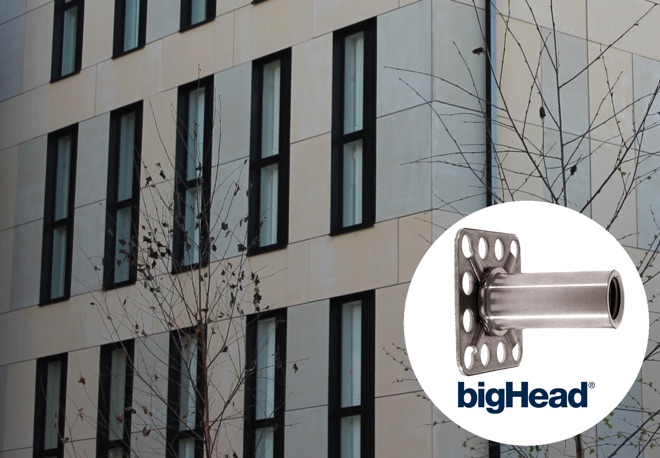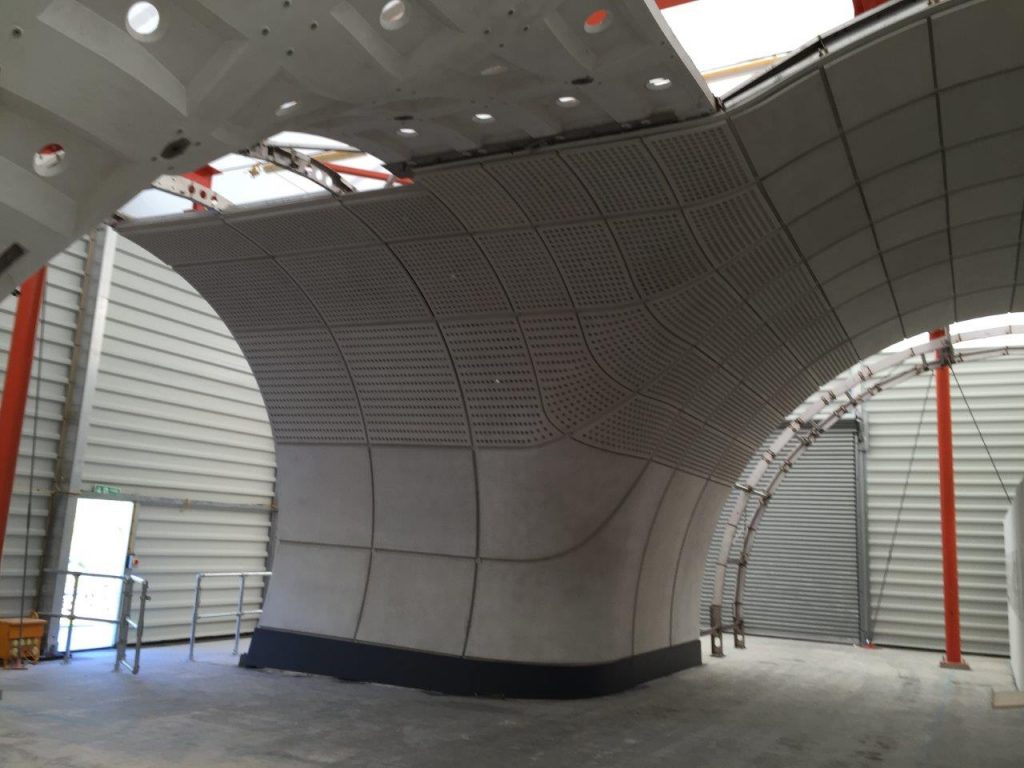
Fastening Points

Construction industry GRC panel fastening
Panel fasteners are an important topic in the construction industry and especially in relation to fixing glass fibre reinforced concrete (GFRC or GRC) panels. GRC offers enormous advantages in construction, providing a strong and durable material. GRC panels are often as thin as 13 mm but, although comparatively light, can weigh up to a ton or more. The mechanical systems used to fix them together must be strong, resistant to corrosion and almost always be invisible to an onlooker. This can be a challenge.
bigHead® Bonding Fasteners has addressed question by developing, in consultation with construction engineers and suppliers, embedding practices for GRC panel fasteners ensure a very strong and reliable attachment which remains hidden. The system is versatile and adaptable and maximises design freedom without compromising strength or quality. It also minimises on-site assembly effort and time.
So, what are GRC panels and what benefits do they offer?
Glass reinforced concrete (GRC) is a composite material comprising a mixture of hydraulic cement, silica sand, alkali resistant (AR) glass fibres and water. The glass fibres effectively reinforce the mortar mix thereby improving its tensile and flexural characteristics. The concrete stabilises the position of the glass fibres, while the fibres are themselves the load bearing constituent of the material. Without the glass fibres the concrete would crack or break under high loads. The higher the percentage of fibre the greater the strength, 3% being the most widely accepted minimum but the workability decreases as the percentage nears 10%. The orientation of the fibres is important too, one-dimensional reinforcing being the most effective method as it uses the least amount of reinforcing material to resist tensile loads.
This strong durable material can be painted, coloured and textured. It also offers sound insulation, fire resistance and can achieve BREEAM M+ material ratings. It can be moulded into a wide variety of complex shapes and profiles and is ideally suited to the popular fast-track approach of using lightweight, prefabricated cladding panels for building exteriors, tunnel wall coverings and other architectural structures.
The main advantage of GRC panels over the corresponding precast concrete alternatives in the considerable saving in weight. It is 80% lighter than its steel equivalent and this improves the energy efficiency rating of the material. There are significant savings in the costs of transportation, handling and erection of the panels. If this weight advantage is considered at the design stage, it may be possible to effect substantial economies in the design of foundations and superstructures for high rise building constructions. Other notable advantages of GRC cladding are its durability, chemical resistance, non-combustibility, impact resistance and good sound/heat insulation properties.
The Glass Fibre Reinforced Concrete Association (GRCA) provides much useful information on its website https://www.grca.online/
Why and how did bigHead develop GRC embedded fastening systems?
The panel fastener must be able to become embedded in the panel and withstand very high loads – both tensile and shear – conforming to strict safety margins.
GRCA lists the functions of the fixings as follows
- to secure the cladding panels to the building for the life of the panels and/or building,
- to allow translational and rotational movements to occur between individual panels and between the panel(s) and supporting structure whilst maintaining waterproofing at the joints
- to provide sufficient adjustment to accommodate normal constructional inaccuracies in combination with the anticipated movements referred to above
- to maintain integrity of support and restraint under all conditions of exposure (impact, vibration, wind, fire, etc.) by minimising local concentrations of stress in the GRC,
- to provide lifting points for the cladding during manufacture, handling and erection,
- to ensure that forces transmitted through the fixings are distributed over as wide an area of GRC as possible,
- to utilise the full-strength properties of the GRC by providing supports at the base of the panels and lateral restraints at both the top and bottom of the panels.
GRC cladding panels should not be ‘over-fixed’ as this can result in cracking of the panel. The term ‘over-fixed’ does not necessarily limit the number of fixings e.g., four fixings for rectangular panels. It really means that the panel must be free to move and/or rotate at each support as detailed by the designer.
Developing solutions in conjunction with construction industry partners
bigHead worked closely with construction industry engineers and suppliers to develop panel fastener prototypes for meticulous design development followed by stringent testing. This has resulted in well proven success in applications over several years – including notable London-based construction and tunnelling projects. We have accumulated substantial technical data that demonstrates the panel fastener’s strength under tensile and shear loads. We can provide extensive data with different material grades and panel thicknesses, minimum edge distances and recommended anchor depths. Tensile load-to-failure test results show that bigHeads can withstand very high loads that yield impressive safety margins. Increasing the size of the “Head” on the bigHead will increase the load values the panel can withstand.

The bigHead GRC embedded panel fastener system
The general principle of our system allows for minimum panel thickness with less additional GRC material required. This simpler and more cost-effective manufacturing model removes the need for secondary fixing processes on-site, helping to prevent on-site assembly mistakes. Another concept includes single (or could be multiple) embedded bigHead panel fasteners used to secure channelled brackets.
For both examples, by using a proprietary aluminium support framework and a simple template system, on-site façade assembly time is minimised, saving project costs. The 316 stainless steel bigHeads are corrosion resistant and, being completely discrete, allow full rear panel fixing with solid unencumbered front facings.
We have CE accreditation and compliance approved status for Construction Products Regulation. This certificate of conformity allows us to supply declarations of performance for its CE-marked stainless steel bigHead panel fasteners that meet stringent tests and the challenging standards for tensile and torque performance that the construction industry demands. Our weld technology, fully documented production testing and ISO 9001:2015 quality system ensures that every fastener produced is strong, safe and reliable.
For more information on embedding panel fasteners in GRC panels, visit the tecHub, register and download the guide ‘Embedding in Glass Reinforced Concrete (GRC)’
This blog has also been featured in FastFix Technology: LINK
